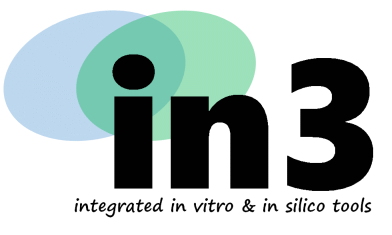
ESR1: Differentiation of renal proximal tubule-like cells from iPSC and application to nephrotoxicity testing
ESR2: Generation of a glomerular model from iPSC and application to nephrotoxicity testing
ESR3: iPSC derived endothelial cells
ESR4: Differentiation of brain like endothelial cells from iPSC and application to BBB toxicity testing and prediction of CNS distribution
ESR5: Differentiation of brain cells from iPSC and application to neurotoxicity testing
ESR6: Generation of Fluorescent reporter iPSCs
ESR7: Differentiation of hepatocyte-like cells from iPSC and application to hepatotoxicity testing
ESR8: Development of iPSC derived alveolar models and application to toxicity testing
ESR9: Development of iPSC derived Conducting Airways and application to toxicity testing
ESR10: New in silico models for safer chemicals
ESR11: New read across modules for safer chemicals
ESR12: Modelling of quantitative Adverse Outcome Pathways
ESR13: P-glycoprotein modelling: New methodology of combining molecular modelling with in silico models for safer chemicals
ESR14: In vitro and in vivo biokinetics assessment
ESR15: Data management and Bioinformatics
in3 ESRs
|
ESR 1: Vidya Chandrasekaran v.chandrasekaran@vu.nl |
ESR 2: Cormac Murphy c.murphy@vu.nl |
%20small.jpg) ESR 3: Zahra Mazidi. Zahra.Mazidi@evercyte.com |
ESR 4: Sara Wellens sara_wellens@ens.univ-artois.fr |
ESR 5: Caroline Nunes carolina.nunes@unil.ch |
|
ESR 6: Aurore Bourguignon aurore.bourguignon@ biotalentum.hu |
ESR 7: Sreya Ghosh sreyahillol.ghosh@kuleuven.be |
 ESR 8: Leonie Fransen leonie.fransen@phe.gov.uk |
 ESR 9: Ivo Djidrovski ivo.djidrovski@newcells biotech.co.uk |
ESR 10: Kristijan Vukovic kristijan.vukovic@marionegri.it |
 ESR 11: Ana Yisel Caballero ana.caballero@marionegri.it |
ESR 12: Nicoleta Spînu N.Spinu@2017.ljmu.ac.uk |
ESR 13: Liadys Mora Lagares liadys.moralagares@ki.si |
ESR 14: Susana Proença s.proenca@uu.nl |
ESR 15: Pranika Singh pranika@douglasconnect.com |
Person in charge: Prof. Dr. Paul Jennings
e-mail: p.jennings@vu.nl
This project will involve the optimisation, characterisation and utilisation of induced pluripotent stem cells for the derivation of donor specific proximal tubule (PT) epithelial cells. Work will involve cell culture, molecular biology approaches, in vitro toxicity assays and mechanistic toxicology including transcriptomics.
Potential outcomes:
- An optimised iPSC derived PT differentiation protocol characterised with respect to xenobiotic handling and tissue specific expression and to challenge the models with nephrotoxins
- Investigation of donor specific effects
- To challenge the optimised system to the in3 compounds and perform mechanistic and kinetic studies
- Deployment of reporter iPSC and testing it with a larger compound set
- To create and challenge a renal AOP with PT cells as the initiating / affected cell
ESR2: Generation of a glomerular model from iPSC and application to nephrotoxicity testing
Host organization:
Vrije Universiteit Amsterdam, The Netherlands
Person in charge: Prof.
Dr. Paul Jennings
e-mail: p.jennings@vu.nl
This project will involve the optimisation, characterisation and utilisation of induced pluripotent stem cells for the derivation of donor specific podocyte cells. Work will involve cell culture, molecular biology approaches, in vitro toxicity assays and mechanistic toxicology including transcriptomics.
Potential outcomes:
- A glomerular model from iPSC incorporating podocyte-like cells and autologous endothelial cells which can be used to investigate compound / nanomaterial glomerular filtration rates and also predict glomerular toxins
- Investigation of donor specific effects utilising iPSC from donors with monogenetic glomerular disorders
- To expose the glomerular models to in3 test compounds for mechanistic and kinetic analysis and modeling
- To create and challenge a renal AOP with the glomerulus as the initiating or affected site
ESR3: iPSC derived endothelial cells
Host organisation: Evercyte GmbH, Vienna, Austria
Person in charge: Prof. Regina Grillari
e-mail: Regina.Grillari@evercyte.com
This project will involve the optimisation, characterisation and utilisation of induced pluripotent stem cells for the derivation of donor specific endothelial cells. Work will involve cell culture, molecular biology approaches, in vitro toxicity assays and mechanistic toxicology including transcriptomics.
Potential outcomes:
- A generic donor-matched endothelial model with specific characteristics and responses
- Investigation of donor specific effects utilising iPSC from donors
- To expose the endothelial model to in3 test compounds for mechanistic and kinetic analysis and modeling
- To create and challenge a vascular AOP
- To create endothelial co-cultures with kidney, liver and lung systems and characterised altered endothelial phenotypes due to cross talk
ESR4: Differentiation of brain like endothelial cells from iPSC and application to BBB toxicity testing and prediction of CNS distribution
Host organisation: University of Artois, Lens, France
Person in charge: Ass. Prof. Maxime Culot
e-mail: maxime.culot@univ-artois.fr
This project will involve the optimisation, characterisation and utilisation of induced pluripotent stem cells for the derivation of donor specific blood brain barrier cells. Work will involve cell culture, molecular biology approaches, in vitro toxicity assays and mechanistic toxicology including transcriptomics.
Potential outcomes:
- An iPSC derived BBB differentiation protocol suitable for both toxicity testing and transport studies characterised with respect to xenobiotic handling and tissue specific expression will be challenged with toxic compounds to identify the window of opportunity for exposure
- Investigation of donor specific effects
- To challenge the optimised system to the in3 compounds and perform mechanistic and kinetic studies
- Deployment of reporter iPSC and testing it with a larger compound set
- In collaboration with ERS5 to create a brain AOP and use the mechanistic and kinetic data to challenge and refine the AOP
ESR5: Differentiation of brain cells from iPSC and application to neurotoxicity testing
Host organisation: University of Lausanne, Lausanne, Switzerland
Person in charge: Dr. Marie Gabrielle Zurich
e-mail: Marie-Gabrielle.ZurichFontanellaz@unil.ch
This project will involve the optimisation of protocols for the derivation of donor specific brain-like cells (i.e neurons, astrocytes and oligodendrocytes) in a 3D structure from induced pluripotent stem cells ( iPSCs).
Furthermore, microglial cells will also be derived from the same iPSCs and added the 3D structures in order to produce a complete 3D model of human origin able to produce a neuroinflammatory response upon toxic exposure. Work will involve cell culture, molecular biology approaches, in vitro toxicity assays and mechanistic toxicology including transcriptomics.
Potential outcomes:
- An iPSC derived 3D model of the brain suitable for neurotoxicity testing including evaluation of inflammatory response upon toxicant exposure
- Investigation of donor specific effects
- To challenge the optimised system to the in3 compounds and perform mechanistic and kinetic studies
- Deployment of reporter iPSC and testing it with a larger compound set
- In collaboration with ERS4 to create a brain Adverse Outcome Pathway having neuroinflammation as converging event
ESR6: Generation of Fluorescent reporter induced pluripotent stem cells (iPSCs)
Host organisation: Biotalentum, Gödöllö, Hungary
Person in charge: Prof. Andras Dinnyes
e-mail: andras.dinnyes@biotalentum.hu
The project will involve the incorporation of reporter constructs into selected iPSC lines using CRISPR/Cas technology to generate fluorescent reporters of toxicity pathways, which can be then differentiated into the other lineages. Genes within the Nrf2 and p53 pathways will be initially targeted. Depending on the progress, multiple labels may be attempted and other pathways investigated. Then the response of undifferentiated iPSC to in3 compounds will be tested in order to compare the responses of the reporter and its parent lineage. The work will therefore involve biomolecular approaches, cell culture and the use of viability assays, stress assays, transcriptomics and kinetic assays.
Potential outcomes:
- Development of iPSCs reporter lines for at least two toxicity pathways (Nrf2 and P53)
- Investigation of donor specific effects
- To challenge the reporter iPSCs with the in3 compounds and compare these results to the parental iPSC lines
- To transfer the reporters to the other laboratories and to monitor differentiation progress
- To carry out differentiation protocols in house and challenge these with a larger compound set in order to investigate transferability, reproducibility, and robustness of the protocols
ESR7: Differentiation of hepatocyte-like cells from induced pluripotent stem cells (iPSCs) and application to hepatotoxicity testing
Host organisation: University of Leuven, Leuven, Belgium
Person in charge: Prof. Catherine Verfaillie
e-mail: catherine.verfaillie@med.kuleuven.be
The project will involve the improvement of protocols to derived hepatocyte-like cells (HLCs) from iPSCs using combinations of genome engineering to enhance/suppress key transcriptional networks, and achieve more advanced 2D and 3D cultures. These cultures will then be used to investigate uptake, extrusion and metabolism of model compounds and exposed to the in3 test compounds with cell viability measured. Work will involve cell culture, molecular biology approaches, in vitro toxicity assays and mechanistic toxicology.
Potential outcomes:
- An iPSC derived hepatocyte differentiation protocol suitable for toxicity testing
- Investigation of donor specific effects, initially using donors with P-gp mutations
- Deployment of reporter iPSC and testing it with a larger compound set
- To create and challenge liver Adverse Outcome Pathways including steatosis and cholestasis
ESR8: Development of induced pluripotent stem cells (iPSCs)-derived small airway models and application to toxicity testing.
Host organisation: Public Health England, Centre for Radiation, Chemical and Environmental Hazards, Oxfordshire, United Kingdom
Person in charge: Dr. Martin Leonard
e-mail: martin.leonard@phe.gov.uk
The project will involve aim to re-produce and optimise methods for the derivation small airway (including bronchiolar and alveolar) of alveolar cells from iPSC progenitors utilising published protocols. Utilising air/liquid cultures and introducing autologous endothelial cells as partner cells in attempt to re-capitulate the processes involved in alveolar gas exchange including surfactant production. Optimisation of bronchiolar epithelial cell differentiation will also be carried out. Once characterised these cultures will be used in an air-liquid interface environment for exposure to nanoparticles, chemical aerosols and the in3 compound set for mechanistic and kinetic assays. Cellular uptake, transport and solubility of nanomaterials and / or chemicals into and through epithelial barriers will also be assessed on a limited scale to build appropriate dosing assessment into “test” risk characterisation strategies. Work will involve cell culture, molecular biology approaches, in vitro toxicity assays and mechanistic toxicology. Potential outcomes:
Potential outcomes:
- iPSC derived small airway differentiation protocols in an air-liquid interface suitable for toxicity testing
- Investigation of donor specific effects, initially using donors with P-gp mutations
- To challenge the optimised system to the in3 compounds and perform mechanistic and kinetic studies
- Deployment of reporter iPSC and testing it with a larger compound set
- To create a pulmonary Adverse Outcome Pathway by conducting a systematic review to identify hazards from chemical and nanomaterial inhalation exposure
ESR 9: Development of iPSC derived Conducting Airways and application to toxicity testing.
Host organisation: NewCellsBiotech, Newcastle, United Kingdom
Person in charge: Prof. Lyle Armstrong
E-mail: lyle.armstrong@newcastle.ac.uk
This project will involve the optimisation of protocols for the derivation of donor specific conducting airway epithelium with the necessary multicellular components of ciliated epithelial cells, Clara cells, goblet cells and basal cells. The method will be optimised and characterised for expression of cell type specific markers, cell type distribution and the response to compounds. The system will also be challenged with chemical aerosols and nanoparticles in the air compartment.
Potential outcomes:
- An iPSC derived conducting airway differentiation protocol in an air-liquid interface suitable for toxicity testing
- The model will be characterised with respect to drug and nanoparticle handling and tissue specific expression of ciliated epithelia, Clara, goblet, and basal cells. The model will be challenged with toxins and nanoparticles to investigate application to toxicity scenarios and to identify the window of opportunity for exposure
- Investigation of donor specific effects, initially using donors with P-gp SNPs
- To challenge the optimised system to the in3 compounds and perform mechanistic and kinetic studies
- Deployment of reporter iPSC and testing it with a larger compound set
- To create and optimise a pulmonary AOP in collaboration with ESR8 working on conducting airways this will involve a systematic review to identify hazards from chemical and nanomaterial inhalation exposure
ESR10: New in silico models for safer chemicals.
Host organisation: Istituto di Ricerche Farmacologiche Mario Negri, Milan, Italy
Person in charge: Prof. Emilio Benfenati
E-mail: emilio.benfenati@marionegri.it
To project aims to develop improved in silico models for cosmetics and other substances, with reference to the endpoints of the project. The main goal is to establish a sound basis for the use of QSAR models for the assessment of chemicals, integrating the results several QSAR models for the same endpoint, and taking advantage, when useful, of the results of related endpoints, such as metabolism. ESR10 will acquire the practical skills for using the several QSAR models within different platforms, such as VEGA, EPISuite, Toxtree, TEST, OECD toolbox, CORAL, R and will also evaluate possible integration of different programs within a single platform. New models will be developed, applying software such as SARpy and QSARpy. ESR10 will assess the applicability domain of the best models for the chemicals which will be studied within in3 with the in vitro and in silico models. The results of the in vitro models addressed within in3 will be investigated, in order to extract rules for toxicity and implement them within VEGA (www.vega-qsar.eu).
Potential outcomes:
- New QSAR models with reference to AOPs will be developed, and implemented within VEGA.
- Evaluation of other tools for use within the consortium for in vitro and in silico data integration.
- Implementation of the tools for chemical safety assessment of project related compounds and models.
ESR11: New read across modules for safer chemicals.
Host organisation: Istituto di Ricerche Farmacologiche Mario Negri, Milan, Italy
Person in charge: Prof. Emilio Benfenati
E-mail: emilio.benfenati@marionegri.it
The project aims to develop improved read-across modules, with reference to the endpoints of the project.To learn VEGA, SARpy, QSARpy, IstChemFeat, AMBIT, OECD Toolbox. The main goal of ESR2 is to establish a sound basis for the use of read-across for the assessment of chemicals, and then to integrate the results of the QSAR models with results from read-across. ESR11 will acquire the practical skills for using read-across, including the software such as ToxRead, AMBIT and OECD toolbox. New modules for read-across will be implemented within ToxRead (www.toxread.eu), and made freely available. The new innovative approach, suitable within a weight-of-evidence perspective, will be made available within the platform ToxRead (www.toxgate.eu).
Potential outcomes:
- New read-across modules which address the AOPs will be developed.
- Development of software to integrate QSAR and read-across.
- Implementation of the tools for chemical safety assessment of project related compounds and models.
ESR12: Modelling of quantitative Adverse Outcome Pathways
Host organisation: Liverpool John Moores University, Liverpool, United Kingdom
Person in Charge: Prof. Mark Cronin
E-mail: M.T.Cronin@ljmu.ac.uk
The project will be responsible for AOP building and qAOP development and ultimately coding the qAOPs. The ESR will create an information collection sheet and work with other ESRs to create a strategy for AOP development for kidney, lung, liver, brain and vasculature. Pre-existing AOPs at the OECD will be incorporated where appropriate. In collaboration with ESR 15 the AOPs will be populated with data from pre-existing sources such as SEURAT-1, DETECTIVE and Predict-IV. Project data (kinetic and mechanistic) will be used to verify and optimise these AOPs and create quantitative relationships. These models will be anchored on suitable in vivo data obtained for the compounds representing either the organ level adverse effects or potency. The quantitative aspect of these relationship will be investigated to allow for qAOP formation. This will be an iterative process allowing for optimisation of the qAOPs from systems toxicology level data. The formalised qAOPs for different organ level toxicities will be placed in a mathematical model framework and coded with e.g. KNIME, R etc. Ultimately a software tool will be developed and combined with the read-across and QSAR models enabling input of both chemical structure and data from the assays for the key events e.g. combining the qAOP model with ToxRead. This integrated modelling approach will enable predictions to be made supported by both relevant chemistry and mechanistic biology.
Potential outcomes:
- Scoping of AOPs for kidney, liver, lung, brain and vasculature
- Population of AOP constructs with data from existing sources
- Creation of qAOPs with project data
- Mathematical model of the qAOP with the possibility to predict potency
- A software tool to combine kinetics, read-across and qAOPs
ESR13: P-glycoprotein modelling: New methodology of combining molecular modelling with in silico models for safer chemicals
Host organisation: National Institute of Chemistry, Ljubljana, Slovenia
Person in charge: Prof. Marjana Novič
e.mail: Marjana.Novic@ki.si
The project aims to develop a methodology for improved in silico models including characterization of substrate specificity and P-gp transport of exogenous chemicals. The main goal is to develop in silico approaches that provide rapid and cost-effective screening platforms for the identification of P-gp substrates as well as for their transport characteristics. This will involve pharmacophore modelling and molecular docking aiming to predict P-gp inhibition properties of small drug molecules or pharmacologically-relevant P-gp substrates. This sub-project will combine the outcome of the molecular modelling results with the predictions resulting from QSAR models developed within the project. The in vitro studies performed by project partners will be utilized and compared with the in silico results to generate a two way optimisation.
Potential outcomes:
- Identification of molecular interactions from docking studies of P-gp with substrates relevant in cosmetics and other substances of concern within the project.
- Combination of QSAR prediction results with the molecular modelling outcome in order to integrate in vitro and in silico data.
- Implementation of the tools for chemical safety assessment of project related compounds and models.
ESR14: In vitro and in vivo biokinetics assessment
Host organisation: Universiteit Utrecht, Utrecht, The Netherlands
Person in charge: Ass. Prof. Nynke Kramer
E-mail: N.I.Kramer@uu.nl
The project aims to analytically assess the difference in in vitro biokinetics between the test chemicals and between newly developed in vitro assays, as well as assess the influence of in vitro biokinetics assessment on the potential of the iPSC systems (in comparison with other existing in vitro systems) to predict human relevant modes of toxicity and toxic doses. Also the project aims to compare the intrinsic toxic potencies of a selected group of test chemicals, physiologically based pharmacokinetic (PBPK) models will be developed to estimate human relevant toxic doses from in vitro determined ‘point of departures’, which have been analysed by ESRs at partner institutions. The ESR will make use of existing PBPK modelling platforms such as the population-based PBPK software SimCyp Simulator® with Mech KiM module to simulate internal tissue/cell concentration/time profiles of test chemicals from external exposure regimes for their accumulation potential in the organs of interest, as well as derive steady state plasma concentrations and daily human oral doses from in vitro effect concentrations. Such modelling platforms allow for the comparison of toxic potencies of the iPSC individuals compared to specific population groups.
Potential outcomes:
- Identification of in vitro system components and physicochemical properties affecting the accumulation of test chemicals over time in iPSC systems.
- To provide a proof-of-principle strategy to estimate human NOAEL for organ-specific toxic chemicals.
- To develop a whole body PBPK simulation of the test compounds from the different donor backgrounds.
ESR15: Data management and Bioinformatics
Host organisation:
Douglas Connect, Basel, Switzerland
Person in charge: Dr. Barry Hardy
e-mail:
barry.hardy@douglasconnect.com
The project will involve creating an in3 data base to host external and project data for easy utilisation by all ESRs. Pre-existing data and project data will be analysed to uncover tissue specific markers of toxicity and molecular initiating events and other key events of toxicity. This will factilitate the generation of appropriate reporter lines and the development of AOPs. Common statistical rules will be established and applied for all project data. Project data will be analysed to investigate tissue specific and donor specific effects. The project will also be aligned to OpenTox activities, bringing best practice on open source and open standards to the project, hence improving on the current fragmented tool culture, improving sustainability and transparency.
Potential outcomes:
- Creation of an optimised data base with toxicogenomic data from large data-bases
- Bioinformatic analysis of pre-existing data to support decisions for reporter assay generation
- To apply a common statistical analysis to all project data
- Generation and population of AOPs
- Analysis of project data for tissue and donor specific effects
 |
in3 is funded by the Marie Skłodowska-Curie Action - Innovative Training Network under grant no. 721975. |